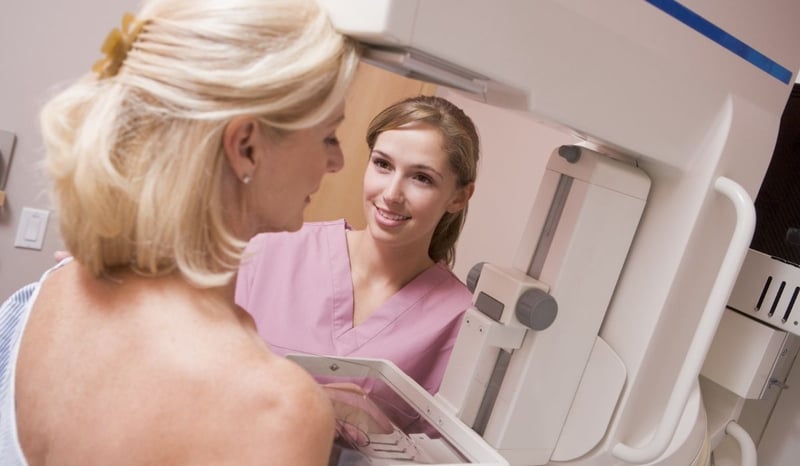
If you’ve had a mammogram and were told you have dense breast tissue, you may be wondering what that means. While having dense breasts is normal and common, many women are left feeling uncertain regarding whether there is anything they should do differently or how it affects the risk of getting breast cancer.
What Does it Mean to Have Dense Breasts?
Breasts contain glandular, connective, and fat tissue. Breast density is a term that describes the relative amount of these different types of breast tissue as seen on a mammogram. Dense breasts have more glandular tissue and fibrous connective tissue and than fatty breast tissue — making it more difficult to see a breast tumor on a mammogram.
Dense breasts can be inherited. Younger women, more than older women, tend to have dense breasts, since breast density typically decreases with age. According to Susan G. Komen, approximately 50-60 percent of women ages 40-44 have dense breasts, compared to 20-30 percent of women ages 70-74.
The Breast Imaging Reporting and Database Systems (BI-RADS) reports mammogram findings and classifies breast density into four groups:
- Category A - mostly fatty: The breasts are made up of mostly fat and contain little fibrous and glandular tissue, which means the mammogram would likely show anything that was abnormal.
- Category B - scattered density: The breasts have quite a bit of fat, but there are a few scattered areas of fibrous and glandular tissue.
- Category C - consistent density: The breasts have many areas of fibrous and glandular tissue that are evenly distributed through the breasts, making it harder to see small masses in the breast. This is also called heterogeneously dense.
- Category D - extremely dense: The breasts have a lot of fibrous and glandular tissue, which may make it hard to see a tumor on a mammogram since the cancer can blend in with the normal tissue.
Category C and Category D breasts are considered dense. Mammogram facilities in the United States are mandated by the FDA to report breast density as either dense or not dense.
The Connection Between Breast Density and Cancer
Women with dense breasts have a higher risk of breast cancer than women with fatty breasts, and the risk increases with increasing breast density. Research has shown that women who have dense breasts are 6 times more likely to develop breast cancer. In addition to that, dense breasts can make it harder for mammograms to detect breast cancer. This is because there is not enough fatty tissue surrounding the tumor to make it easily visible.
Having dense breast tissue doesn't necessarily mean you're more likely to get breast cancer or that a mammogram won't find it. However, knowing your breast density can help you and your doctor make informed choices about breast cancer screening. Studies show that women with dense breasts are just as likely to survive breast cancer as women with less dense breasts, when other health factors and tumor details are taken into account.
What Does that Mean for Your Mammogram?
Only a mammogram can show if a woman has dense breasts. However, because dense breast tissue appears white on a mammogram, as do some abnormal breast changes like calcifications and tumors, it can make it more difficult to find cancer on a standard screening. Because of this, women with dense breasts have more false-negative results, which indicate that there is no disease present even though it really is.
If you have dense breasts, you may be called back for follow-up tests more often than women with fatty breasts. A three-dimensional (3D) mammogram may be recommended, which takes multiple X-ray images of each breast from different angles without compressing the tissue. These images are combined to create a clear 3D picture, making it easier to detect potential cancer.
In some cases, your doctor may recommend a breast ultrasound or a magnetic resonance imaging (MRI) for further testing to confirm if breast cancer is present. Studies have shown that both can help detect some breast cancers that can’t be seen on mammograms. Insurance may not always cover these procedures, but it could be important, especially if you have dense breasts or other risk factors.
If I Have Dense Breasts, What Should I Know About My Cancer Risk?
Having dense breast tissue has been linked to increased risk of developing breast cancer, though the reasons for this aren't entirely clear. It's important to talk to your doctor about your personal risk for developing breast cancer. Your doctor will consider other factors, such as:
- Age
- Height and weight
- Past breast biopsies
- Personal or family history of breast or ovarian cancer
- Hormone use
- Ashkenazi Jewish heritage
- Age of first menstrual period, childbirth, or menopause
- Any previous cancer diagnoses
These factors will help your doctor determine if you're at an average, intermediate, or high risk for breast cancer. Knowing your personal risk level helps guide your doctor in recommending the most appropriate screening for you.
Steps You Can Take to Lower Your Risks of Breast Cancer
One important step you can take is to make certain lifestyle changes that could help lower your risk for developing breast cancer. These may include:
- Keeping a healthy weight
- Exercising regularly
- Eating a nutritious diet
- Quitting smoking
- Reducing your alcohol intake
In addition to lifestyle changes, another important step is keeping up with your regular breast screenings. According to the American Cancer Society this includes:
- Yearly mammogram for women ages 40-54,
- Mammograms every two years for women age 55 and older,
- Continued screenings as long as the woman is in good health and expected to live at least 10 more years.
Talk to your doctor about developing a breast cancer screening plan that is tailored to your unique situation so you can have peace of mind.
Originally published September 2018. Updated September 2024.


